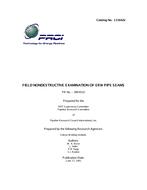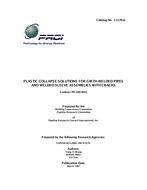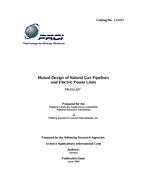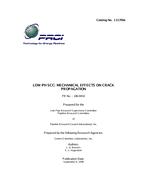Provide PDF Format
PRCI PR-185-926
- Field Non-Destructive Evaluation of ERW Pipe Seams
- Report / Survey by Pipeline Research Council International, 06/17/1991
- Publisher: PRCI
$198.00$395.00
L51642e
Edison Welding Institute
Need: Electric resistance welded (ERW) pipe has been used in the natural gas transmission industry for many years. The Department of Transportation (DOT) has recently expressed interest in the integrity of the weld seam in pipelines made from ERW pipe that was manufactured prior to 1970. Specifically, the DOT has requested that natural gas transmission and hazardous liquid pipeline operators determine whether or not their pipelines that meet this description require hydrostatic proof testing. The initial concern from the DOT was for seam weld selective corrosion, although reference has since been made to growth of manufacturing discontinuities in the ERW seam. Early ERW pipe was manufactured using either direct current or low-frequency alternating current, processes that were prone to producing incomplete fusion discontinuities. These discontinuities (also referred to as cold welds, penetrators, etc.), if present in a pipeline, can grow under normal service or under upset operating conditions resulting in leaks or ruptures. There exists a need for a method that a pipeline operator could use to demonstrate the integrity of pipelines that were made from this older ERW pipe other than hydrostatic testing, which is expensive and potentially harmful to pipeline integrity. The use of a nondestructive-examination (NDE) technique would enable an operator to sample the integrity of a suspect pipeline during other routine in-service maintenance operations without the need for hydrostatic testing.
Result: The detection of incomplete fusion discontinuities is difficult if not impossible with conventional NDE techniques. The intimate mechanical contact between compressed surfaces causes a small amount of reflection and a large amount of transmission of ultrasonic signals. Recently however, several ultrasonic techniques have been introduced to study these types of discontinuities in resistance spot welds and inertia friction welds. These new techniques are based on ultrasonic spectroscopy, that is, the frequency dependence of the various ultrasonic interfacial parameters. These parameters include reflection and transmission coefficients and the frequency dependence of ultrasonic volumetric parameters (e.g., velocity and attenuation).
Benefit: This report describes the adaptation of these techniques to incomplete fusion discontinuities in the seam of ERW pipe.
Edison Welding Institute
Need: Electric resistance welded (ERW) pipe has been used in the natural gas transmission industry for many years. The Department of Transportation (DOT) has recently expressed interest in the integrity of the weld seam in pipelines made from ERW pipe that was manufactured prior to 1970. Specifically, the DOT has requested that natural gas transmission and hazardous liquid pipeline operators determine whether or not their pipelines that meet this description require hydrostatic proof testing. The initial concern from the DOT was for seam weld selective corrosion, although reference has since been made to growth of manufacturing discontinuities in the ERW seam. Early ERW pipe was manufactured using either direct current or low-frequency alternating current, processes that were prone to producing incomplete fusion discontinuities. These discontinuities (also referred to as cold welds, penetrators, etc.), if present in a pipeline, can grow under normal service or under upset operating conditions resulting in leaks or ruptures. There exists a need for a method that a pipeline operator could use to demonstrate the integrity of pipelines that were made from this older ERW pipe other than hydrostatic testing, which is expensive and potentially harmful to pipeline integrity. The use of a nondestructive-examination (NDE) technique would enable an operator to sample the integrity of a suspect pipeline during other routine in-service maintenance operations without the need for hydrostatic testing.
Result: The detection of incomplete fusion discontinuities is difficult if not impossible with conventional NDE techniques. The intimate mechanical contact between compressed surfaces causes a small amount of reflection and a large amount of transmission of ultrasonic signals. Recently however, several ultrasonic techniques have been introduced to study these types of discontinuities in resistance spot welds and inertia friction welds. These new techniques are based on ultrasonic spectroscopy, that is, the frequency dependence of the various ultrasonic interfacial parameters. These parameters include reflection and transmission coefficients and the frequency dependence of ultrasonic volumetric parameters (e.g., velocity and attenuation).
Benefit: This report describes the adaptation of these techniques to incomplete fusion discontinuities in the seam of ERW pipe.
Related Products
PRCI Report Of Investigations 5836
Effect Of Methyltrichlorosilane On Permeability Of Sandstone Cores To Gas And Water..
$6.00 $12.00





